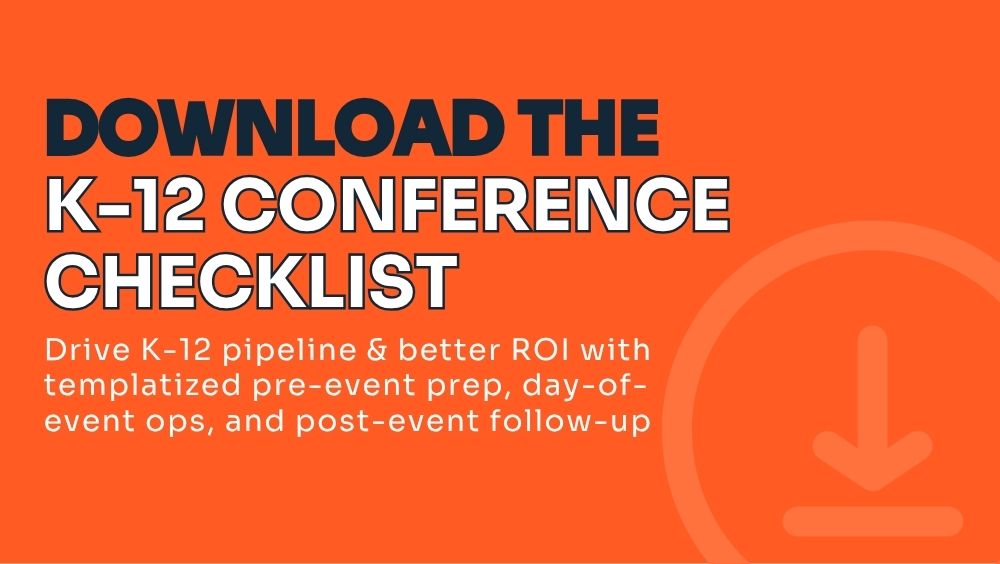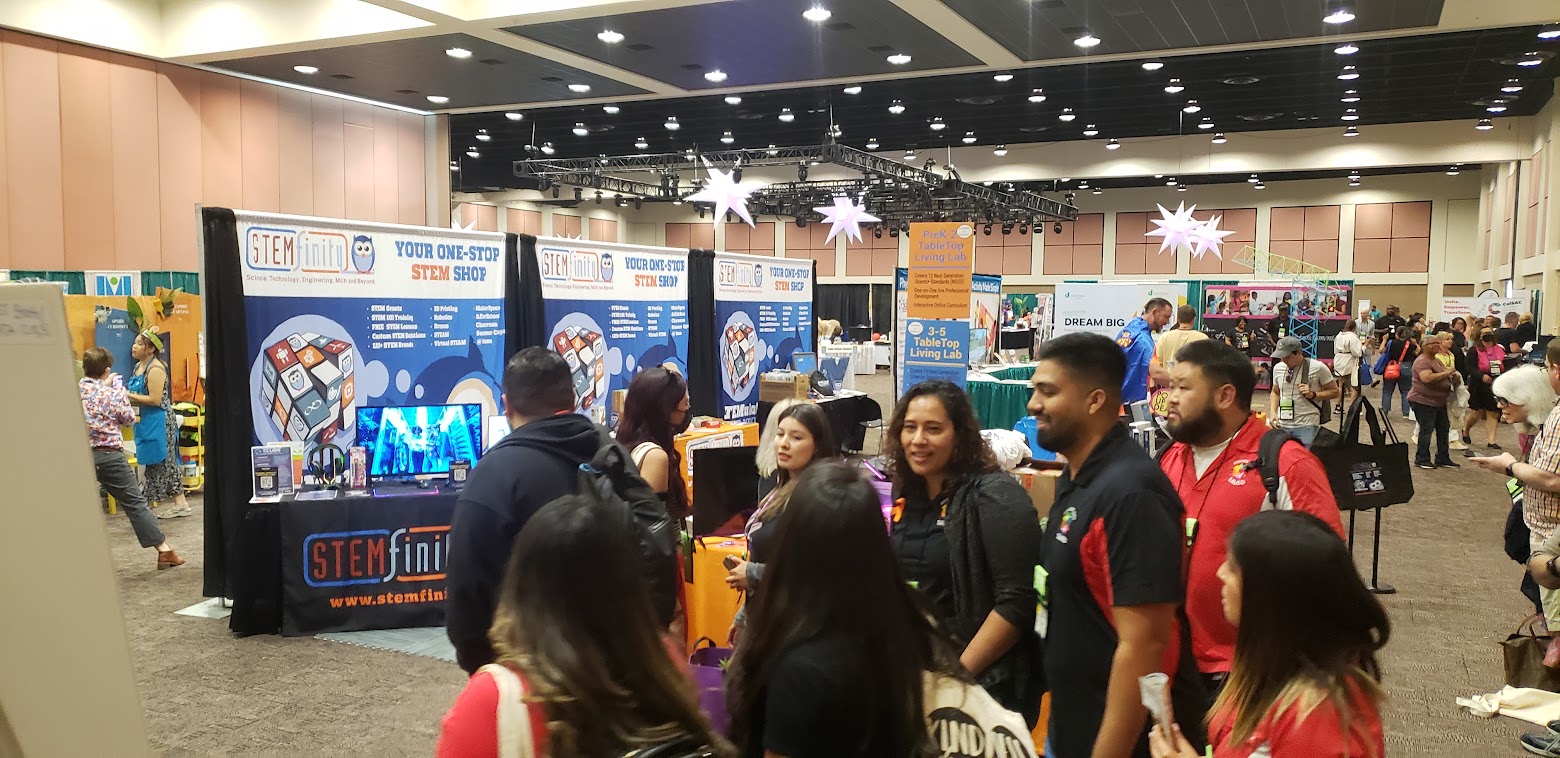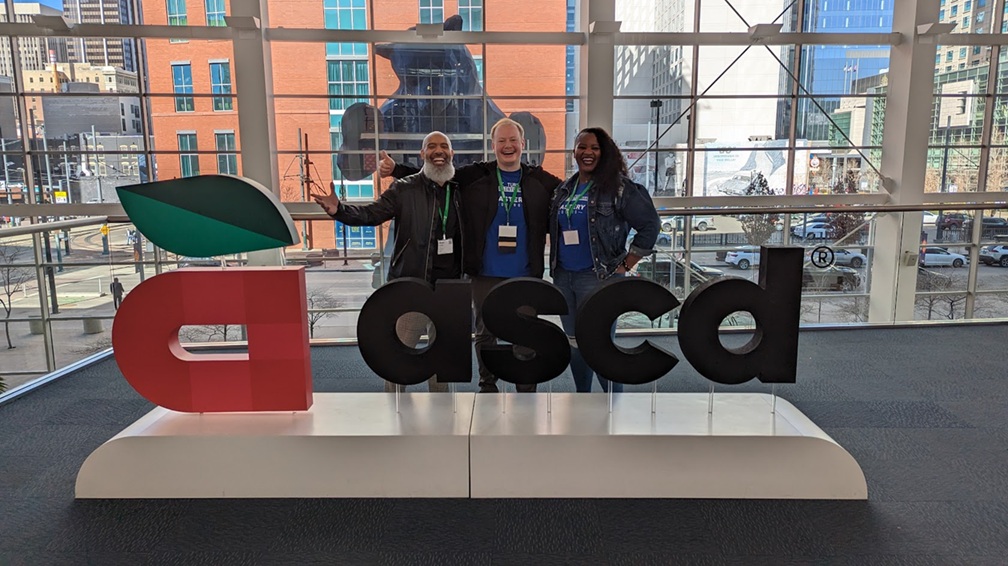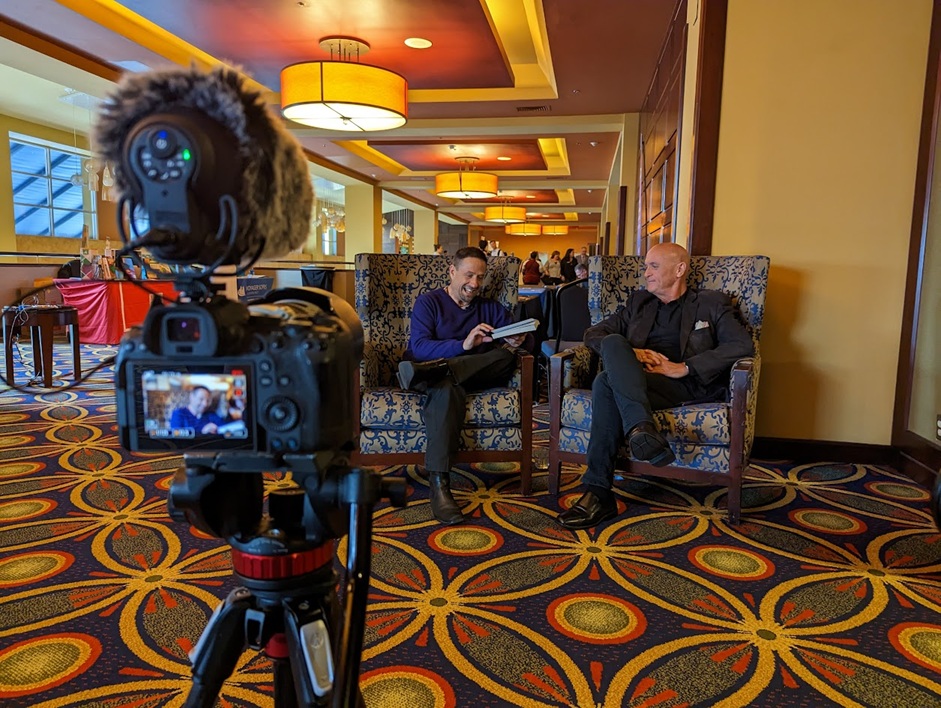First, let me get this out of the way: I’m not here to dissuade you from exhibiting at ISTE, AASA, TCEA, or any of the other big edtech conferences. They have their place, and the experience and opportunities you create by attending one are irreplaceable (Trust me, I’ve been to 50+ edtech conferences). But if you’re a lean edtech team with a finite budget, the math (and my experience) says you’ll get a better return by skipping the mega shows and owning several state, district, or even school-level events instead.
Why? Because attention is a scarce commodity on an expo floor and at the big shows, your 10×10 sq ft. booth is one tiny raindrop in a hurricane. I’ve watched many great products (and booths) disappear in the shadow of a guitar-shredding Elvis and a 12-foot vending machine with free stuffed toys (thanks, Kami). Cute? Yes. Do attendees love it? Yes. Will your booth stand out in comparison? No.
Be a bigger fish in a smaller pond, and you’ll have way more real conversations, more follow-ups, and more pipeline you can definitively connect with your event marketing efforts.
The Attention Math: Why Big EdTech Conferences Underperform for EdTech Founders
Big shows create an optical illusion: huge crowds, nonstop noise, “great energy,” and “so many good conversations.” But walk the floor and you’ll notice the attendees clustering around the booths with big footprints and bigger budgets. If you’re not one of them, your team spends two days fighting for eye contact while serious K-12 buyers follow a route of ‘stops’ and ‘check-ins’ they mapped out weeks before the doors opened.
At smaller state or district events, you can actually own a category conversation. People remember you. Your demos and conversations run longer. You build connections and understand context, instead of just scanning badges. And when you follow up, reply and meeting booking rates are higher because the interaction wasn’t a 30-second drive-by to grab some free swag.

Field Result: 55% More Sales with Fewer Conferences
From 2023 to 2024, I led a shift to fewer, smarter events for a national edtech provider I was working with. We built a criteria to help us choose events, scored shows rigorously after attending, tracked all ROI, doubled down on the ones where our ICP density was obvious, fixed our booth flow for demos & conversations (not photo ops), and ran disciplined 7-14 day follow-ups with our sales team.
The result: 55% more sales from events and their follow-up year over year, while attending fewer conferences and scanning fewer badges. We didn’t outspend anyone. We out-focused and out-data’d them.
The Actual Cost: One EdTech National Event vs. Three Local School & District Wins
If you’ve ever paid for a big-show booth, you know the cost: space, drayage, union labor, electricity, shipping, travel, hotels, overpriced food, carpet, furniture, Wi-Fi, A/V, plus sales collateral, swag, and “mandatory” sponsorships. By the time you’re done spending, you could have bought yourself a 2020 Honda Accord with decent mileage.
With the budgets I’ve managed, the total cost of one mega show often equals two to three well-chosen state, local, or district events. That means:
- 3× the pre-event prospecting windows
- 3× the speaking/session opportunities
- 3× the chances to be remembered
- 3× the follow-up cycles that turn into meetings
If your goal is pipeline, that trade is a no-brainer. Plus, local district events build trust through proximity. K12 district buyers prefer working with local brands and edtech founders.
Case Study: Turning Spring CUE’s STEM Zone into K12 District Pipeline
.jpg)
At Spring CUE in Palm Springs, I oversaw the execution of a 5,000 sq ft STEM Zone and designed it for hands-on demos and connections, not selfies or swag distribution. We brought in partners (Microsoft, iBUYPOWER, and six others), built the floor plan, laid out a simple “prizing passport” game to drive traffic, and staffed stations for K12 connections and district conversations.
The results:
- 750+ participants engaged
- 253 marketing qualified leads captured
- $12,500+ in committed sponsorships
I came in under budget target by negotiating fees, streamlining transport and AV setups, and increasing in-kind commitments from our K12 partners. The lesson: when you capitalize on the “first-mover advantage,” show up with a plan and make the experience about educators doing, not just looking, you leave with real contacts, real context, and a real connection for your follow-up. And, of course, you can’t be afraid to roll up your sleeves and handle the move-in, setup, and tear-down yourself, as well as working the K12 conference (don’t leave your new salesperson alone at the booth while you galavant around the expo).

“Smaller” at a K12 Conference Doesn’t Mean “Smaller Impact”
Two quick think-outside-the-box sponsorship examples to make your budget go further and create more lead gen opportunities:
- BOOST (Best of Out-of-School Time Conference): I’ve attended/exhibited at BOOST in Palm Springs on five or six different occasions. Booths aren’t cheap, but the conference offers a variety of other sponsorships that allow orgs to make a big splash (literally). Like last year, when I joined an EdTech CEO and Teacher-of-the-Year Award Winner in the pool of the conference expo hotel, for the beloved Duck-Duck-BOOST swimming challenge. The cost of the sponsorship? $350 and a sprained ankle. The number of impressions and conversations generated for hundreds of after-school admins crowding the pool to watch Duck-Duck-BOOST? Countless. In the following weeks, we had hundreds of tags across socials from educators posting photos of us splashing in the pool and mentioning our brand.

Community-Cred Plays
- Riot Games Studio Tour: Through our connections in Southern California, we brought students and district leaders from LACOE and AUHSD on a tour of the world-famous game studio and esports arena. Not only did this generate goodwill with potential clients and easy renewal conversations with existing ones, but we generated a TON of media content, positive testimonials, and templated the field trip for repeat runs with external sponsorship.
Both efforts created more trust and better follow-ups than a random hallway chat at a mega show because they were high-intent, high-engagement experiences that created lasting memories of our brand.
When Mega Shows Still Make Sense (Be Strategic)

Sometimes, the big pond is the right pond:
- You’re launching a new brand or a category-defining product and NEED to make a big impression
- You’ve lined up analyst/press briefings and partner summits around the show.
- You’re co-boothing with a major partner who’ll drive foot traffic straight to your demo station.
- You secured a killer speaking slot that your buyers will attend, or several hands-on workshops.
If you go, do strategic prep: book meetings or chances to connect in advance, host your own off-floor suite or dinner, and measure success by meetings and opps (and how soon they materialize), not just badge scans or conversations.
Try the EdTech Conference Scoring Calculator, which can help you weigh the costs vs. potential ROI of an event.
Measure What Matters (Not Just “Badges Scanned”)
Track the full path and lifecycle of leads you collect from edtech events:
- Leads → Quantity, Channels (and Cost) of Follow-up →Meetings Booked → Opportunities Created → Wins for Your K12 Pipeline
- Time-to-first-meeting (shorter is better - some K12 sectors have much quicker sales cycles than others)
- Cost per qualified demo booked from each event (I cut this from $12 to $10.5 for a client over one year, with fewer conferences and resulting in 55% more in post-event sales)
- Content captured (usable photos/video, testimonials, tags) and where it’s reused
- Post-event reply rate and meeting-set rate (we consistently see higher ratios from smaller state conferences, K-12 district events, and school vendor shows)
If you can’t connect the event to booked meetings and opps within 2-4 weeks, it might not be worth returning to.

Your 30-Day Action Plan: Reallocate for Results
- Kill one mega show on your calendar.
- Fund 2–3 state/district events with that budget (CTE, STEM, regional admin groups, district STEAMFests). Find ones you can get to without expensive airfare, lodging, or shipping!
- Lock one speaking slot at each and co-host with a partner or reseller. Keep submitting session proposals until your keyboard breaks.
- Prep your 7-day follow-up kit (Email sequence (3-5x emails), lead qualifiers, a short Loom demo, and a one-pager).
- Map competitors and potential partners ahead of time, assign revenue ownership, and prep the follow-up sprint before heading to the event.
Do this once and you’ll feel the difference in your inbox and calendar in the weeks after the event.
Grab the Toolkit (Free)
If you want to run this play exactly how we do it, here’s the bundle I give clients:
- K12 Event Scoring Calculator
- Pre- and post-K12 Conference checklist
- Follow up Email Scripts + templatized conference ‘activities’ that engage (coming soon!)
Bottom Line
For lean teams and founder-led EdTech startups, big and national doesn’t equal smart. Stop paying for noise and activity. Pay for access and attention - the kind you get when you’re the bigger fish in a smaller pond. Your pipeline (and salespeople) will thank you.
